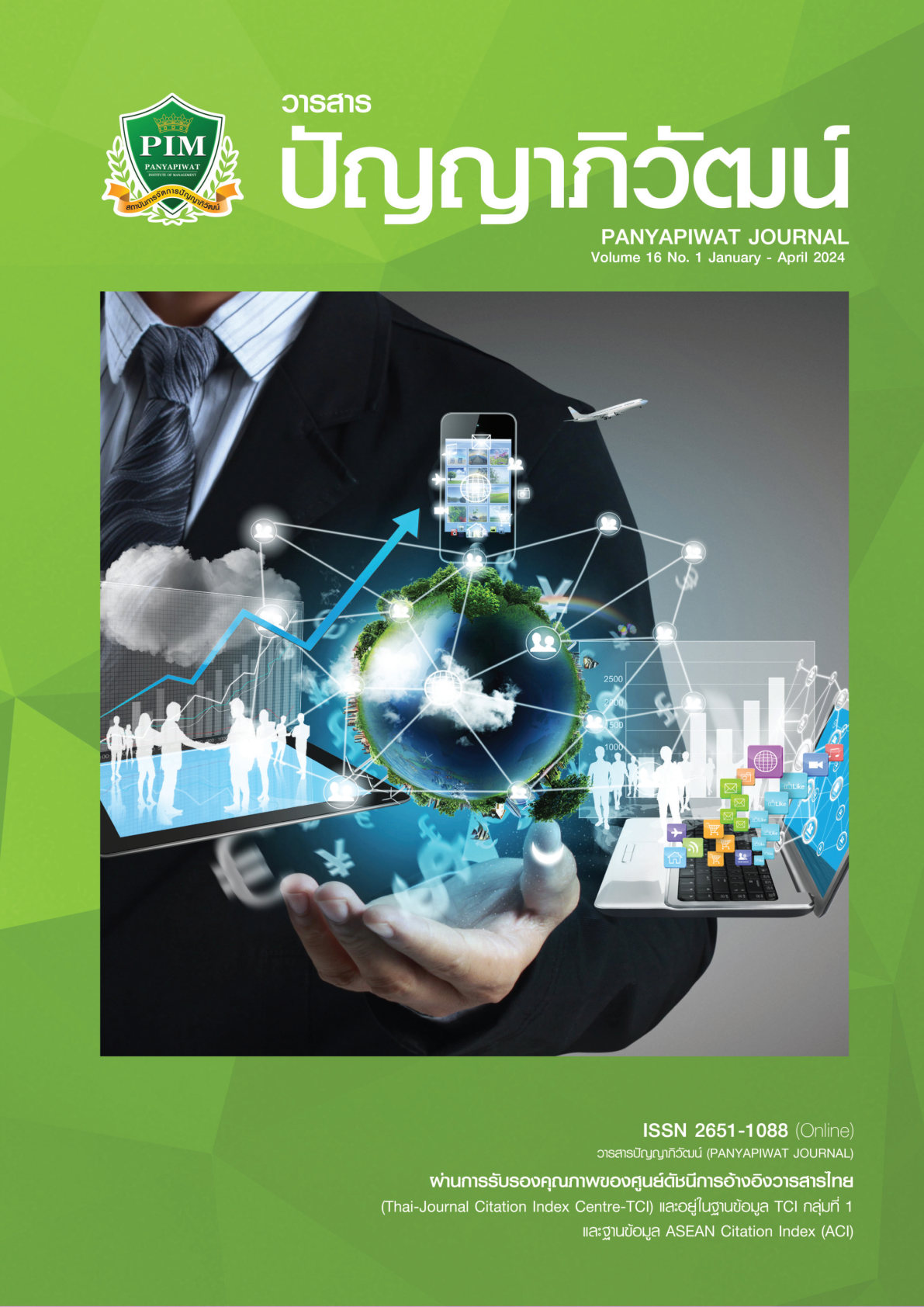ปัจจัยที่ส่งผลต่อการตัดสินใจใช้บริการอินเทอร์เน็ตไฟเบอร์ออฟติกความเร็วสูงอย่างยั่งยืน ของผู้ให้บริการในประเทศไทย
Main Article Content
บทคัดย่อ
งานวิจัยนี้จัดทำเพื่อสำารวจและพัฒนาความเข้าใจเกี่ยวกับกระบวนการตัดสินใจเลือกใช้บริการอินเทอร์เน็ตไฟเบอร์ออฟติกความเร็วสูง (FTTx) ของผู้ให้บริการในประเทศไทย เน้นไปที่แนวคิดของการบริโภคอย่างยั่งยืนโดยเฉพาะในเรื่องของความภักดีของผู้บริโภค วัตถุประสงค์ของการวิจัย ประกอบด้วย 1) เพื่อศึกษาระดับการตัดสินใจในการซื้อบริการ FTTx เพื่อการให้บริการที่ยั่งยืน 2) เพื่อพัฒนาโมเดลปัจจัยเชิงสาเหตุที่มีอิทธิพลต่อการตัดสินใจซื้อบริการ FTTx เพื่อนำไปสู่การให้บริการที่ยั่งยืน และ 3) เพื่อวิเคราะห์ปัจจัยทางตรง ทางอ้อมและอิทธิพลรวมต่อกระบวนการตัดสินใจซื้อบริการ FTTx การศึกษาได้สำรวจกลุ่มตัวอย่างจำนวน 324 คนในประเทศไทย อายุ 18 ปีขึ้นไป ซึ่งเคยใช้บริการอินเทอร์เน็ตไฟเบอร์ออฟติกความเร็วสูง ข้อมูลได้รับการเก็บรวบรวมผ่านแบบสอบถามออนไลน์และวิเคราะห์โดยใช้สถิติเชิงพรรณนา ได้แก่ การแจกแจงความถี่ ค่าร้อยละ ค่าเฉลี่ย ส่วนเบี่ยงเบนมาตรฐาน และสถิติเชิงอนุมาน ได้แก่ การวิเคราะห์องค์ประกอบเชิงยืนยัน และการวิเคราะห์โมเดลด้วยสมการโครงสร้าง ผลการวิจัยพบว่า ข้อมูลสำหรับปัจจัยส่วนบุคคลของผู้ใช้บริการส่วนใหญ่เป็นเพศหญิง อายุ 20-30 ปี การศึกษาระดับปริญญาตรี และประกอบอาชีพในภาครัฐ ด้วยรายได้เฉลี่ยต่อเดือนต่ำกว่า 15,000 บาท โดยมีระยะเวลาการใช้บริการ 8 ปีขึ้นไปเพื่อการหาข้อมูล และผู้ให้บริการอินเทอร์เน็ตที่ได้รับความนิยมสูงสุดคือ NT (CAT & TOT) และผลการวิเคราะห์ข้อมูลเชิงอนุมานพบว่า 1) การตัดสินใจซื้อบริการอินเทอร์เน็ตไฟเบอร์ออฟติกความเร็วสูงของผู้ให้บริการในประเทศไทยเพื่อนำาสู่การให้บริการที่ยั่งยืนอยู่ในระดับมาก 2) โมเดลที่พัฒนาสอดคล้องกับข้อมูลเชิงประจักษ์ 3) ด้านการตั้งใจซื้อได้รับอิทธิพลทางอ้อมจากคุณภาพการบริการทางอิเล็กทรอนิกส์ ด้านการตลาดผ่านสื่อสังคมออนไลน์ และด้านการรับรู้นวัตกรรม (r2 = 0.86) และด้านการตัดสินใจเลือกใช้บริการได้รับอิทธิพลโดยตรงจากด้านความตั้งใจซื้อ (r2 = 0.84) ซึ่งเน้นย้ำถึงบทบาทสำคัญของปัจจัยเหล่านี้ในการยอมรับบริการอย่างยั่งยืนและการตัดสินใจของลูกค้าในภาคบริการอินเทอร์เน็ตความเร็วสูงในประเทศไทย
Article Details

อนุญาตภายใต้เงื่อนไข Creative Commons Attribution-NonCommercial-NoDerivatives 4.0 International License.
“ข้าพเจ้าและผู้เขียนร่วม (ถ้ามี) ขอรับรองว่า บทความที่เสนอมานี้ยังไม่เคยได้รับการตีพิมพ์และไม่ได้อยู่ระหว่างกระบวนการพิจารณาลงตีพิมพ์ในวารสารหรือแหล่งเผยแพร่อื่นใด ข้าพเจ้าและผู้เขียนร่วมยอมรับหลักเกณฑ์การพิจารณาต้นฉบับ ทั้งยินยอมให้กองบรรณาธิการมีสิทธิ์พิจารณาและตรวจแก้ต้นฉบับได้ตามที่เห็นสมควร พร้อมนี้ขอมอบลิขสิทธิ์บทความที่ได้รับการตีพิมพ์ให้แก่สถาบันการจัดการปัญญาภิวัฒน์หากมีการฟ้องร้องเรื่องการละเมิดลิขสิทธิ์เกี่ยวกับภาพ กราฟ ข้อความส่วนใดส่วนหนึ่งและ/หรือข้อคิดเห็นที่ปรากฏในบทความข้าพเจ้าและผู้เขียนร่วมยินยอมรับผิดชอบแต่เพียงฝ่ายเดียว”
เอกสารอ้างอิง
Ajzen, I. (1991). Theory of planned behavior. Organizational Behavior and Human Decision Process, 50(2), 179-211.
Ajzen, I., & Fishbein, M. (1980). Understanding attitudes and predicting social behavior. Prentice-Hall.
Anderson, J. C., & Gerbing, D. W. (1988). Structural equation modeling in practice: A review and recommended two-step approach. Psychological Bulletin, 103(3), 411–423. https://doi.org/10.1037/0033-2909.103.3.411
Comrey, A. (1973). A first course on factor analysis. Academic Press.
Choteladakeetika, C. (2018). The attitude and social media marketing that affecting purchase decision of personalized products via online channel [Master’s thesis]. Bangkok University. [in Thai]
Duangdow, P. (2020). The Causal factors of service quality affecting consumer intention to use broadband internet service in the lower Northern Thailand. Journal of Business Economics and Communications, 15(2), 71-86. [in Thai]
Duangkhae, S. (2020). Factors influencing the sustainability of the customer loyalty in the aging health service business in Thailand [Doctoral dissertation]. Dhurakij Pundit University. [in Thai]
Fanoberova, A., & Kuczkowska, H. (2016). Effects of source credibility and information quality on attitudes and purchase intentions of apparel products: A quantitative study of online shopping among consumers in Sweden [Master’s thesis]. Umea School of Business and Economics. https://umu.divaportal.org/smash/get/diva2:946730/FULLTEXT01.pdf
Fongsri, P. (2014). Construction and development for research too (4th ed.). Dansutra Printing. [in Thai]
Hair, Jr., J. F., Black, W. C., Babin, B. J., & Anderson, R. F. (2010). Multivariate data analysis: A Global Perspective (7th ed.). Pearson Prentice Hall.
Hawkins, I. D., & Mothersbaugh, L. D. (2013). Consumer behavior building marketing strategy (12th ed.). McGraw-hill/Irwin.
Ketpenwong, T. (2022). Social ewom toward brand attitude and brand advocacy of streaming video on demand (svod) brand in Thailand [Master’s thesis]. Mahidol University. [in Thai]
Khongsuebsor, W. (2021). A development of the causal model to influences making decision of student using Universities fitness center [Doctoral dissertation]. Mahasarakham University. [in Thai]
Kittisapkul, O. (2016). Factors affecting the satisfaction and loyalty of customers who use the service High-speed internet (broadband): Case study: Government telecommunications service provider [Master’s thesis]. Thammasat University. [in Thai]
Kotler, P. (2000). Marketing management millennium edition. Marketing Management, 23(6), 188-193
Kline, R. B. (2010). Principles and practice of structural equation modeling (3rd ed.). Guilford Press.
Moore, G., & Benbasat, I. (1991). Development of an instrument to measure the perceptions of adopting an information technology innovation. Information Systems Research, 2, 173-191
Nanchanok, T. (2017). Advertise with Youtube to penetrate the target market with precision and results. Vitty Group. [in Thai]
National Telecom Public Company Limited [NT PLC]. (2023). National telecommunications company enterprise plan 2023-2027. https://www.ntplc.co.th/about-nt/strategies-develop [in Thai]
Nunnally, J. C. (1978). Psychometric Theory. McGraw-Hill Book.
Namahoot, K. S. (2018). An analysis of digital banking adoption using diffusion of Innovation Theory. Warasan Phuettikammasat, Behavioral Science Research Institute, Srinakharinwirot University, 24(2), 43-64. [in Thai]
Oliver, R. L. (1999). Whence consumer loyally. Journal of Marketing, 63, 33-44.
Parasuraman, A., Zeithaml, V. A., & Malhotra, A. (2005). E-S-QUAL: A Multiple-Item scale for assessing electronic service quality. Journal of Service Research, 7(3), 213-234.
Phinijrattanarak, K. (2019). The influence of word-of-mouth communication on the internet on brand attitude. Perceived value of consumption and decision to purchase mobile phones and smartphones. Journal of Business Information Systems, 5(4), 78-100. [in Thai]
Prasitphon, W. (2014). Consumer behavior theory. Phranakhon Rajabhat University. [in Thai]
Rogers, E. M. (1983). Diffusion of innovation (3th ed.). The Free Press.
Sae-io, K. (2016). Impact of the E-Service Quality on Customer’s Repurchase Intention in the Car Fast Fit Service [Master’s thesis]. Prince of Songkla University. [in Thai]
Sawaiamorn, K. (2020). Factors affecting the acceptance of online banking service innovation on financial transaction among customers of Krungthai Bank (Public) company limited in Suphanburi Province [Master’s thesis]. Phranakhon Si Ayutthaya Rajabhat University. [in Thai]
Schumacher, R. E. & Lomax, R. G. (2010). A beginner’s guide to structural equation modeling: SEM. Lawrence Erlbaum Associates.
Siritang, K. (2019). The relationship between electronic service quality and the loyalty of netflix streaming users [Master’s thesis]. Rajamangala University of Technology Thanyaburi. [in Thai]
Sonhom, R., & Supawan, R. (2021). Social media marketing, trendiness, safety and trust, and online shopping motivation affecting the purchase decision on clothes via Instagram store of consumers in Bangkok. In Proceedings of the 14th National and International Conference “Global Goals, Local Actions: Looking Back and Moving Forward 2021” (pp. 260-269). Suan Sunandha Rajabhat University [in Thai]
Sutheewasinnon, P. (2016). Sampling strategies for qualitative research. Parichat Journal Thaksin University, 29(2), 30-48. [in Thai]
Taweewattananon, P., & Yansomboon, S. (2022). Electronic service quality, perceived value, and service satisfaction of digital comics applications. Business Administration Journal, 12(2), 88-99. [in Thai]
Tsai, W. H. S., & Men, L. R. (2013). Motivations and antecedents of consumer engagement with brand pages on social networking sites. Journal of Interactive Advertising, 13(2), 76-87.
Vongassavanarumol, K. (2020). Factors that impact to couriering parcel delivery through online platform in Thailand [Master’s thesis]. Thammasat University. [in Thai]
Zeithaml, V. A., Parasuraman, A., & Malhotra, A. (2002). Service quality delivery through web sites: A critical review of extant knowledge. Journal of the Academy of Marketing Science, 30(4), 362-375.


